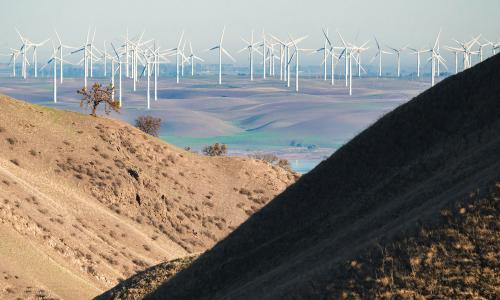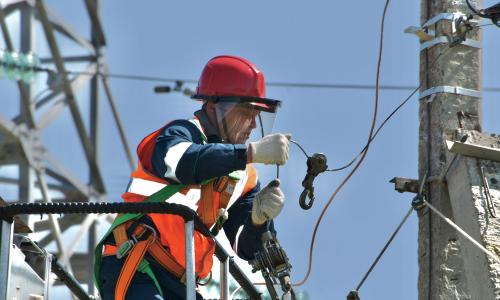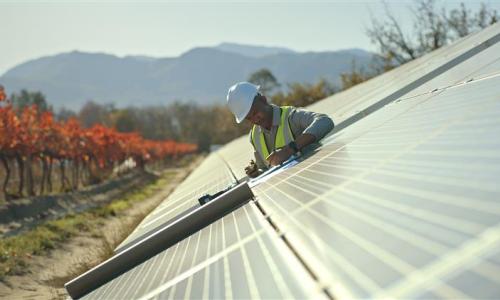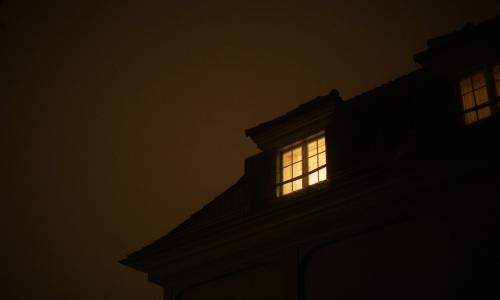Energy expert Laura Wisland discusses how California will implement its 100% clean energy goal.
In this episode
- Laura talks about Senate Bill 100 in California
- Colleen and Laura discuss the move to 100% renewable energy
- Laura explains why having diverse clean energy investments is necessary
Timing and cues
Opener (0:00-0:37)
Intro (0:37-2:11)
Interview part 1 (2:11-12:31)
Break (12:31-13:17)
Interview part 2 (13:17-22:55)
Sidelining Science Throw (22:55-23:08)
Sidelining Science (23:08-27:42)
Outro (27:42-28:44)
Related content
Full transcript
Colleen: Laura, thanks for joining me on the podcast.
Laura: You're welcome. I'm happy to be here.
Colleen: So, California just passed a bill in 2018 called SB100. Can you tell me what that is?
Laura: SB100 stands for Senate Bill 100, and it is a law that was enacted in 2018, and it does two major things. The first thing that it does is it accelerates our goal to put more renewable energy onto the grid. So, the Renewables Portfolio Standard or RPS, before SB100 passed, was a requirement that utilities source 50% of their electricity supplies from renewables by 2030. And SB100 raised that requirement to 60% renewables by 2030. And then the bill does one additional thing, which is it requires a longer-term goal to reach a 100% clean electricity by 2045. So, by 2030, we will have 60% renewables on the grid, and by 2045, we are aiming to reach 100% clean electricity.
Colleen: Sometimes I hear “100% renewable electricity” I hear “100% clean electricity” sometimes it’s “carbon free.” What is the difference?
Laura: Yeah, that’s right. So the 100% goal that we enacted with SB 100 is not 100% renewables. Renewables, at least in California, has a very specific legal definition and it’s a family of carbon free technologies that we traditionally think of as renewables. So things like solar, wind, geothermal, types of hydropower, types of bioenergy. That’s what is included under the RPS in California. When we talk about 100% clean or 100% carbon free, we’re of course talking about those technologies, but that term also includes other types of carbon free generation that aren’t technically renewable. So things like nuclear power, or large hydropower.
Colleen: Where does California currently get its electricity mix?
Laura: We get about a third of our electricity today from renewable resources, things that I just mentioned, solar, wind, geothermal. We get about another third from natural gas. And then the last third comes from a combination of large hydropower. Large hydro supplies usually between about 10% and 15% of our electricity depending on the water year. And then the other bit comes from nuclear and market purchases from outside California, which are usually natural gas, or large hydropower or coal.
Colleen: Does the technology currently exist to meet the goal?
Laura: The technologies definitely exist to meet our 2030 requirement reaching 60% RPS by 2030. We think that we have all the technologies in hand to reach 100% carbon-free or 100% clean by 2045, but it's a little bit less clear what that pathway looks like. And the reason is because when you start talking about really high levels of renewable energy generation technologies on the grid, you need to find ways to store that electricity because it's coming from sources like the wind and sun, so it's not coming 24/7 the way something like stored natural gas is. So, there are some unique technical challenges associated with running a grid with very, very high levels of renewables. We are making a lot of progress on figuring out how to run a grid like that, and we are very confident that by 2045, we will be able to get there.
Colleen: How will California be able to reach this carbon-free goal?
Laura: Yeah, that's a great question. So, let me just break down some of the steps that we think are really important to happen. The first one, of course, is to continue bringing additional sources of renewable electricity generation on the grid. So, keep doing what we've been doing, which is invest in more solar, wind, geothermal, bioenergy, all of the different types of renewable technologies. Luckily, a lot of these technologies, the cost of them has come down considerably. So, that's a great thing. It's the economic choice in addition to the environmental choice.
We also wanna make sure that as we're bringing on more renewables, we're doing, as much as we can, to save electricity and be efficient with that electricity so that we can keep the cost of this clean energy transition down. Obviously, the less we have to use electricity, the more cost-effective any transition is gonna be. We also want to...we're gonna need to bring on additional sources of energy storage because a lot of renewable generation technologies don't generate 24/7. They generate when the sun is shining or the wind is blowing. And, of course, we need to be able to use electricity all the time.
And so, there's a lot of different types of storage technologies that are gonna play a huge role on the system to make sure that we have a consistent supply of electricity. We also need to do more to better align our electricity demand with when renewable energy sources are most abundant. So, in California, we have an incredible solar generation resource. We know we're gonna be bringing on a lot more solar power. Most of that electricity is gonna show up for us in the daytime hours when the sun is shining. There's a lot of electricity demand we have in the state that is currently being demanded at night, but we could shift that during the day and be able to better make use of all that solar generation we're gonna install.
We also need to be doing more to work with our neighbors to share supplies of electricity because if we want to operate a grid with very high levels of renewable generation, we want to be able to draw from as big of a pool of resources as possible. And so, the more we can be coordinating with our neighboring states and taking advantage of their wind when our wind isn't blowing, or giving another state some of our excess solar when they need the power, the more efficient and cost-effective the grid will be.
Colleen: So, are grids, sort of, proprietary? Each state has its grid and are...do they currently cross-pollinate?
Laura: So, states and grid operators are not the same thing, but there's a lot of similarities between a state and a grid operator. Grid operators are usually regional. In California, there is one grid operator that's in charge of operating about 80% of the electricity demand in California. So, in that way, we think of California and one grid operator as one and the same. But in other states, there's utilities that are their own grid operator. And in fact, in California, Los Angeles Department of Water and Power, which is a very large municipally owned utility, it's its own grid operator. So, sometimes states are grid operators, but sometimes they cross boundaries and are more regional. Either way, grid operators, whether they are state-focused or regionally focused, always do share electricity with each other. It's just that we need to do a lot more of it and it needs to happen more dynamically.
Colleen: What do you see as the most challenging part of reaching the goal?
Laura: Yeah. So, I'll just first say that you know, California is the fifth largest economy in the world. We have a lot of people here. We consume a lot of electricity demand. And no other state or even country has really attempted a transition to a 100% carbon-free electricity. So, we are out on the cutting edge of doing this. And so, of course, you know, one of the challenges is not being able to go to another country and just say, "How did you do it? Then we'll just replicate you." So, you know, we're charting the path in a lot of ways. But that said, there are...a lot of the things that we're gonna need to get to a 100% carbon-free, we already have, and it's just a matter of scaling them up. So, things like energy efficiency, bringing more renewables on to the system, deploying energy storage. These are all things that we have been doing and we just need to do more.
I would say one of the biggest challenges is finding ways and deploying technologies that are going to be able to provide us with carbon-free sources of power for days on end, weeks on end when we suddenly lose our solar resource. So, and what we call this is long duration energy storage. So, the market has really exploded for lithium-ion batteries, which helped us to store electricity for a matter of hours. And that's gonna be critical to this transition. But we're also gonna need to find ways to store electricity for days or even weeks when a big storm comes through and the solar generation is really low for a really long time, or you know, there's some other event where we're gonna have to draw on our reserves. That's the piece of technology that isn't quite as developed, and we're gonna need to use some of that long duration energy storage when we're looking at the 2030 to 2040 time frame.
Colleen: Right. Are there any other states that are planning to follow in California's footsteps that you know of?
Laura: Yeah. I mean, the great story is that California is suddenly not alone in this path to 100% clean energy. So, you know, Washington state is working on 100% clean bill by 2045, and it just passed one house and is headed to the next one, and it's, you know, fingers cross, it'll pass. New Mexico just made a commitment to a 100% clean energy, which is huge. Hawaii has had a commitment in place for a while. And I know that there's some discussion about a 100% clean in a couple of states in the Midwest and the East Coast as well. So, we're hoping this is not, you know, we're just the first of many states to take the step.
[Break]
Colleen: Are there particular lessons learned from California that you would share with other states?
Laura: Yeah, I think so. I mean, I think the first one is that your voice really does matter, and you need to let your legislator know that you support this transition. And, you know, coalitions of people representing all different kinds of voices and all different kinds of interests can be very, very powerful in making the case and help build momentum to get policies like this enacted. And then in terms of, you know, what these policies look like, I think it's important to not be too prescriptive. You know, we're talking about 2045. It's a long way away. There's been so much change in innovation in the electricity sector. We know that more of that is gonna happen. So, when we write policies looking at 2045, we wanna make sure they're general enough to make room for innovation and really support new technologies to play a role in the future.
Colleen: So, you need flexibility in there.
Laura: Flexibility. Don't be too prescriptive. And then the last thing is to make sure you're making investments in as many different types of clean energy solutions as possible. There's no one silver bullet, and the minute you do that you make yourself vulnerable to, you know, something going wrong, or it's just a less cost-effective path to go down. So, as you think about the types of renewables you wanna bring on to the grid, make sure they're as diverse as possible. Same with storage technologies. Same with getting creative to figure out how to better align electricity demand with renewable energy supplies. The more different tools we can bring to the table, the easier it's gonna be to make this transition and the cheaper it's gonna be.
Colleen: So, Laura, you can really feel clean energy momentum happening, it just feels like there's no stopping it. But what are you most excited about?
Laura: You know, I'm really excited about this wave of smaller scale technologies that are available to homes and businesses to get people more involved in the clean energy transition. Decades ago, it was just about a utility, making an investment in a really big utility-scale power plant, and we didn't really have a choice. These days, you know, we're still gonna be making investments in big wind farms, big solar farms, but there's also a lot of opportunity to make investments on your rooftop, put a battery in your garage, figure out how to better align your electricity usage towards times of the day when clean energy is most abundant. There's a lot of ways that I think people can get involved in this transition that are fairly new and exciting.
I also, in terms of technology, I'm personally really excited about what offshore wind can do. There's been a pretty hardy conversation about that on the East Coast, and I think us out here in the West have been watching those conversations and trying to take notes and figure out what's been working with that and what's not. But there's a lot of potential on the West Coast, and the wind resources are really strong, and I think if we can figure out how to responsibly permit some of that offshore wind, we're gonna have this, you know, brand new or new-ish resource that we can really use to accelerate this clean energy transition.Colleen: So, I don't know if you know this, but the town that I live in, in Massachusetts Hull, we have two wind turbines. We were trying for many years to be the first offshore wind farm, or not really farm, but we were trying to put four or six turbines off the coast of Hull, and just for our town it was...the cost just...it just didn't work, but we were really invested in doing that, and so I'm, kind of, sad that we weren't the first. But I'm really happy that, yeah, there's a lot happening now.
Laura: And it's so great to hear about communities getting really excited and taking pride in local clean energy in that sense.
Colleen: Absolutely. My town is very...we're very proud of our turbines.
Laura: That's great. I love hearing that because, you know, that's what it's gonna have to be. I think we're gonna have to look at the solar plants we build, and the wind farms, and take real pride in taking charge of our energy future, and making investments in sources that we know are clean and are gonna provide resources to our communities.
Colleen: So, are there any challenges that you think will put a monkey wrench in the momentum?
Laura: So, ironically, climate change, climate change is the impetus for a lot of this momentum, but it's also a threat. And what I mean by that is we have an extensive network of transmission lines, you know, poles and wires across the state that are going to be necessary to make this clean energy transition, and when extreme weather events occur that are exacerbated by climate change, they threaten the stability of the grid. So, you know, wildfires can reduce the efficiency of power lines. They can make it so you can't...you know, it's too dangerous to generate a power plant. We're gonna have to potentially, proactively shut down sections of the grid to protect the grid.
On the flip side, we're now finding that in some cases, the grid can be contributing to climate disaster. So, in California, we're just coming off of a historic drought. We have hundreds of millions of dead trees in the mountains, and any time you have a high wind and the power lines could spark a blaze. We're finding out that a lot of the huge fires that happened last summer in California were because of power lines. And so, a lot of our attention about investments needed for the grid are being redirected away from clean energy transformation and towards how do we make the grid more climate resilient and not susceptible to causing climate disasters. And we want to make sure that if we're having a conversation about ways to update the grid so that it doesn't spark wildfires, which we know we need to have, let's figure out how to couple those investments with investments that will also help accelerate our clean energy transition.
Colleen: So, very complex problems that you need to solve.
Laura: Nobody said it was easy. Nothing California does is ever simple.
Colleen: Is there anything else we need to consider when we’re making this transition?
Laura: The biggest part of the transition really to getting to 100% clean electricity in California is where the rubber meets the road is basically reducing our reliance on natural gas generation and figuring out how to scale down our usage of natural gas. One of the things we want to make sure happens when we look at the path off natural gas looks like is making sure we’re turning down generation and hopefully retiring gas plants first, that are located in the communities that have disproportionally been impacted by air pollution. We want to make sure that as we scale away from gas we’re targeting communities where people are breathing the worst air first.
Colleen: Are there bad health effects from natural gas?
Laura: There are bad effects of natural gas. Natural gas emits nitrogen oxides, which, you know, causes...forms smog and contributes to asthma. Natural gas plants emit particulate matter, which, you know, causes respiratory problems, heart disease problems. So, you know, it is important to make sure we're turning down generation from the dirtiest plants because most likely in California, they're also located in the communities that are most low income and, you know, have disproportionately borne the brunt of air pollution. So, helping to target the dirtiest plants first will help those communities.
That said, the largest contributor to air pollution and pollution that harms public health comes from our transportation sector, from cars and trucks. We know that clean electricity is actually gonna play a huge role in helping public health there because we're gonna be electrifying cars and trucks. So, we're, hopefully, in the near future, gonna be taking off the road a lot of diesel trucks, a lot of gasoline-powered cars, and instead, powering them with clean electricity, and that is gonna have a dramatic public health impact and improvement, you know, not only for everybody in the state, but particularly, the communities that are bearing the brunt of living next to a highway and breathing in all the air pollution from cars and trucks.Colleen: Laura, what's gonna happen when everybody wants to move to California?
Laura: Come on in. I don't know. Housing prices are gonna be even worse.
Colleen: No. No. All right. Well, Laura, thanks for joining me on the podcast.
Laura: Thanks. This has been really fun.
Credits
Sidelining Science: Shreya Durvasula
Editing and music: Brian Middleton
Research and writing: Pamela Worth
Executive producer: Rich Hayes
Host: Colleen MacDonald



